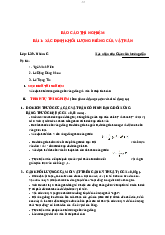



Preview text:
lOMoARcPSD|46958826 lOMoARcPSD|46958826
General Physics Laboratory Report EXPERIMENT
DETERMINATION OF GRAVITATIONAL
ACCELERATION WITH A REVERSIBLE PENDULUM Class: L05 / Group: A/Team:1 Lecturer’s comment Full name:
1) Nguyễn Hồng Quân 2) Trần Anh Khoa
3) Nguyễn Trương Phước Thọ 4) Ngô Huy Dịch
5) Dương Hoàng Huy I. Aims/Purposes:
............................................................................................................................................................
............................................................................................................................................................
............................................................................................................................................................
............................................................................................................................................................
II. Method, Equipment and Procedure:
............................................................................................................................................................
............................................................................................................................................................
............................................................................................................................................................
............................................................................................................................................................ III. Equations:
............................................................................................................................................................
............................................................................................................................................................
............................................................................................................................................................
............................................................................................................................................................ IV. Experimental Data: 4.1 Table 1: Weighted position (mm) 50T1 (s) 50T2 (s) x0 = 0 mm 83.98 83.31 x0+40 = 40mm 84.31 84.56 x1 = 32 mm 84.21 84.35 lOMoARcPSD|46958826 4.2 Raw data:
4.3 Table 2: At the best position x1', physical pendulum becomes T1= T2 = T: Best position x'1 =32 (mm) Data 50T1 (s) (50T1) 50T2 (s) (50T2) 1 84.17 0.0167 84.15 0.0033 2 84.2 0.0133 84.13 0.0167 3 84.19 0.0033 84.16 0.0133 Mean 84.1867 0.0111 84.1467 0.0111 V. Calculations:
5.1 Determine the oscillating period of the reversible pendulum:
❖ Random error of T: = 50. 2 = 1.6833( ) 1 (50 1+50 2)
❖ Calculate the mean period T of the r e v e rsible pendulum from the values in table 2:
❖ Systematic error of ∆ = 2 50 . = 0.0002( ) 1 (∆( 50 1 )+∆ (50 2 ))
❖ Absolute error of T: ∆ = 0.015 = 0.0002( ) 0 ∆ = ∆
+ ∆ = 0.0002 + 0.0002 = 0.0004( ) T: 5.2 Calculate the = 4 2 2 = 9.743( 2 ) = 3.14 ∆ = 0.005
gravitational acceleration: and => ̅ = 2 + ̅ + 2 = ̅
❖ Calculate the mean value of gravitational acceleration: VI. Conclusions:
∆ = . ̅= 0.0051 × 9.7529 = 0.0497( 2)
❖ Calculate the relative error of g: ∆ ∆ ∆ ∆ lOMoARcPSD|46958826 = ± ∆ = . ± . ( )




